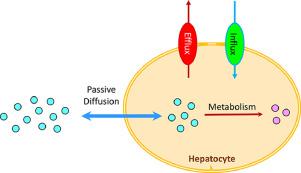European Journal of Pharmaceutical Sciences ( IF 4.3 ) Pub Date : 2020-09-12 , DOI: 10.1016/j.ejps.2020.105541
Christopher Keefer 1 , George Chang 1 , Anthony Carlo 1 , Jonathan J Novak 1 , Michael Banker 1 , Jackie Carey 1 , Julie Cianfrogna 2 , Heather Eng 1 , Caitlin Jagla 1 , Nathaniel Johnson 1 , Rhys Jones 2 , Samantha Jordan 1 , Sarah Lazzaro 1 , JianHua Liu 1 , R Scott Obach 1 , Keith Riccardi 1 , David Tess 3 , John Umland 1 , Jillian Racich 1 , Manthena Varma 1 , Ravi Visswanathan 2 , Li Di 1

|
Human liver microsomes (HLM) and human hepatocytes (HHEP) are two common in vitro systems used in metabolic stability and inhibition studies. The comparison between the assays using the two systems can provide mechanistic insights on the interplay of metabolism, passive permeability and transporters. This study investigated the critical factors impacting the unbound intrinsic clearance (CLint,u) and IC50 of CYP3A inhibition between HLM and HHEP. The HLM/HHEP CLint,u ratio and HHEP/HLM IC50 ratio are inversely correlated to passive permeability, but have no correlation with P-gp efflux ratio. Cofactor-supplemented permeabilized HHEP (MetMax®) collapses the IC50 differences between HHEP and HLM. P-gp inhibitor, encequidar, shows minimal impact on CLint,u and IC50 in HHEP. This is the first study that is able to separately investigate the effects of passive permeability and efflux transport. These data collectively show that passive permeability plays a critical role in metabolism and enzyme inhibition in HHEP, while P-gp efflux has a minor role. This may be due to low functional P-gp activity in suspension HHEP under the assay conditions. Low passive permeability may limit metabolism and enzyme inhibition in HHEP, leading to lower CLint,u and higher IC50 in HHEP compared to HLM. When liver microsomes give higher CLint,u than hepatocytes, microsomes are more predictive of in vivo clearance than hepatocytes.
中文翻译:

当肝微粒体的清除率高于肝细胞中的清除率时,对肝脏微粒体与肝细胞的清除率和抑制不一致性的机理性见解。
人肝微粒体(HLM)和人肝细胞(HHEP)是用于代谢稳定性和抑制研究的两种常见的体外系统。使用这两种系统进行的分析之间的比较可以提供有关新陈代谢,被动渗透性和转运蛋白相互作用的机理性见解。本研究调查了影响HLM和HHEP之间的CYP3A抑制的未结合固有清除率(CL int,u)和IC 50的关键因素。HLM / HHEP CL int,u比值和HHEP / HLM IC 50比值与被动导磁率成反比,但与P-gp外排率无关。辅因子增透的HHEP(MetMax®)使IC 50崩溃HHEP和HLM之间的差异。P-gp抑制剂encequidar对HHEP中的CL int,u和IC 50影响最小。这是第一项能够单独研究被动渗透性和外排传输影响的研究。这些数据共同表明,被动通透性在HHEP的代谢和酶抑制中起关键作用,而P-gp外排则起次要作用。这可能是由于在测定条件下,悬浮液HHEP中的功能性P-gp活性较低。低被动通透性可能会限制HHEP中的代谢和酶抑制作用,从而导致HHEP中的CL int,u较低, IC 50高于HLM。当肝微粒体给出更高的CL int时,u 与肝细胞相比,微粒体对体内清除的预测性更高。

































 京公网安备 11010802027423号
京公网安备 11010802027423号